Page 2805 of 4500
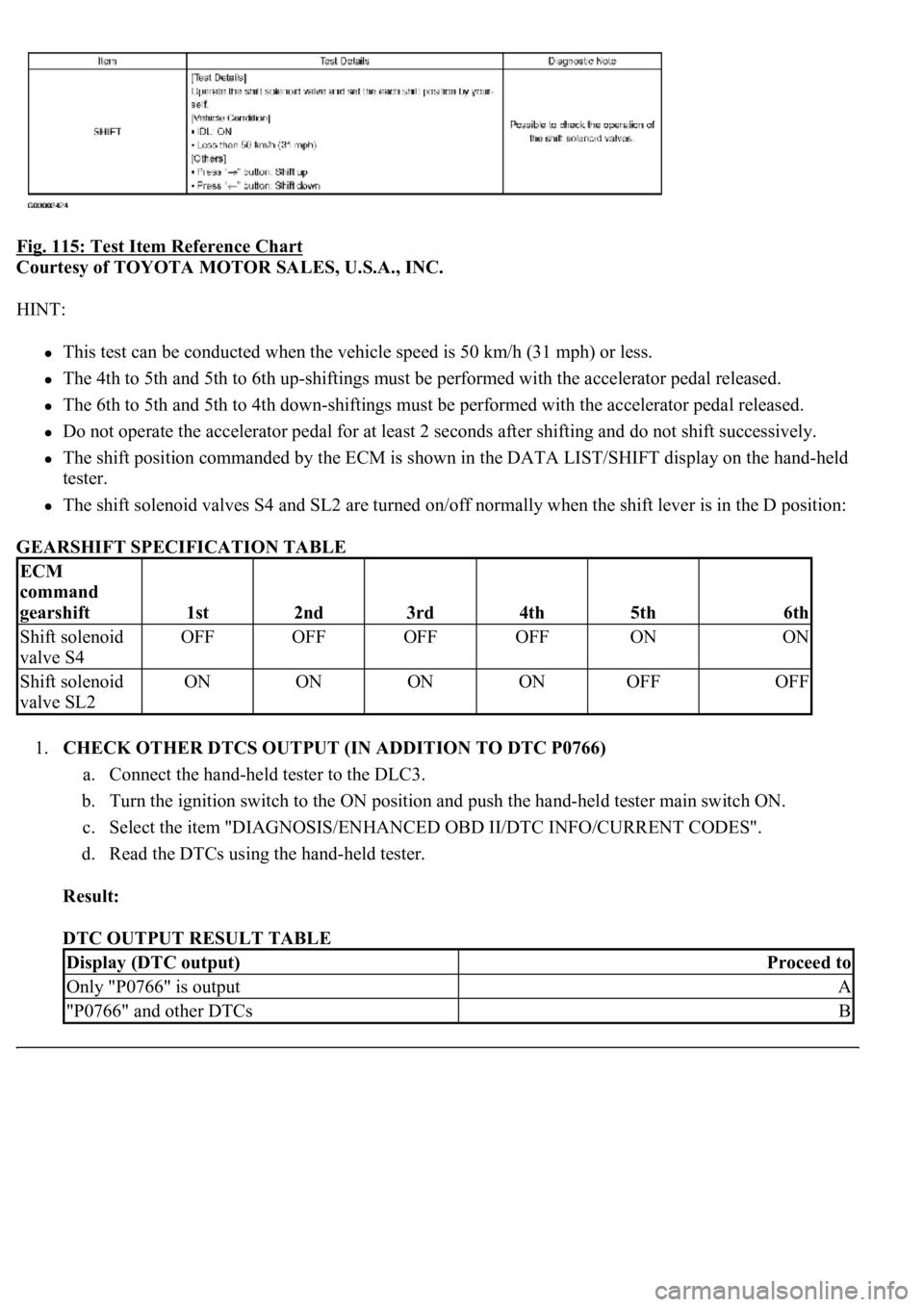
Fig. 115: Test Item Reference Chart
Courtesy of TOYOTA MOTOR SALES, U.S.A., INC.
HINT:
This test can be conducted when the vehicle speed is 50 km/h (31 mph) or less.
The 4th to 5th and 5th to 6th up-shiftings must be performed with the accelerator pedal released.
The 6th to 5th and 5th to 4th down-shiftings must be performed with the accelerator pedal released.
Do not operate the accelerator pedal for at least 2 seconds after shifting and do not shift successively.
The shift position commanded by the ECM is shown in the DATA LIST/SHIFT display on the hand-held
tester.
The shift solenoid valves S4 and SL2 are turned on/off normally when the shift lever is in the D position:
GEARSHIFT SPECIFICATION TABLE
1.CHECK OTHER DTCS OUTPUT (IN ADDITION TO DTC P0766)
a. Connect the hand-held tester to the DLC3.
b. Turn the ignition switch to the ON position and push the hand-held tester main switch ON.
c. Select the item "DIAGNOSIS/ENHANCED OBD II/DTC INFO/CURRENT CODES".
d. Read the DTCs using the hand-held tester.
Result:
DTC OUTPUT RESULT TABLE
ECM
command
gearshift
1st2nd3rd4th5th6th
Shift solenoid
valve S4OFFOFFOFFOFFONON
Shift solenoid
valve SL2ONONONONOFFOFF
Display (DTC output)Proceed to
Only "P0766" is outputA
"P0766" and other DTCsB
Page 2812 of 4500
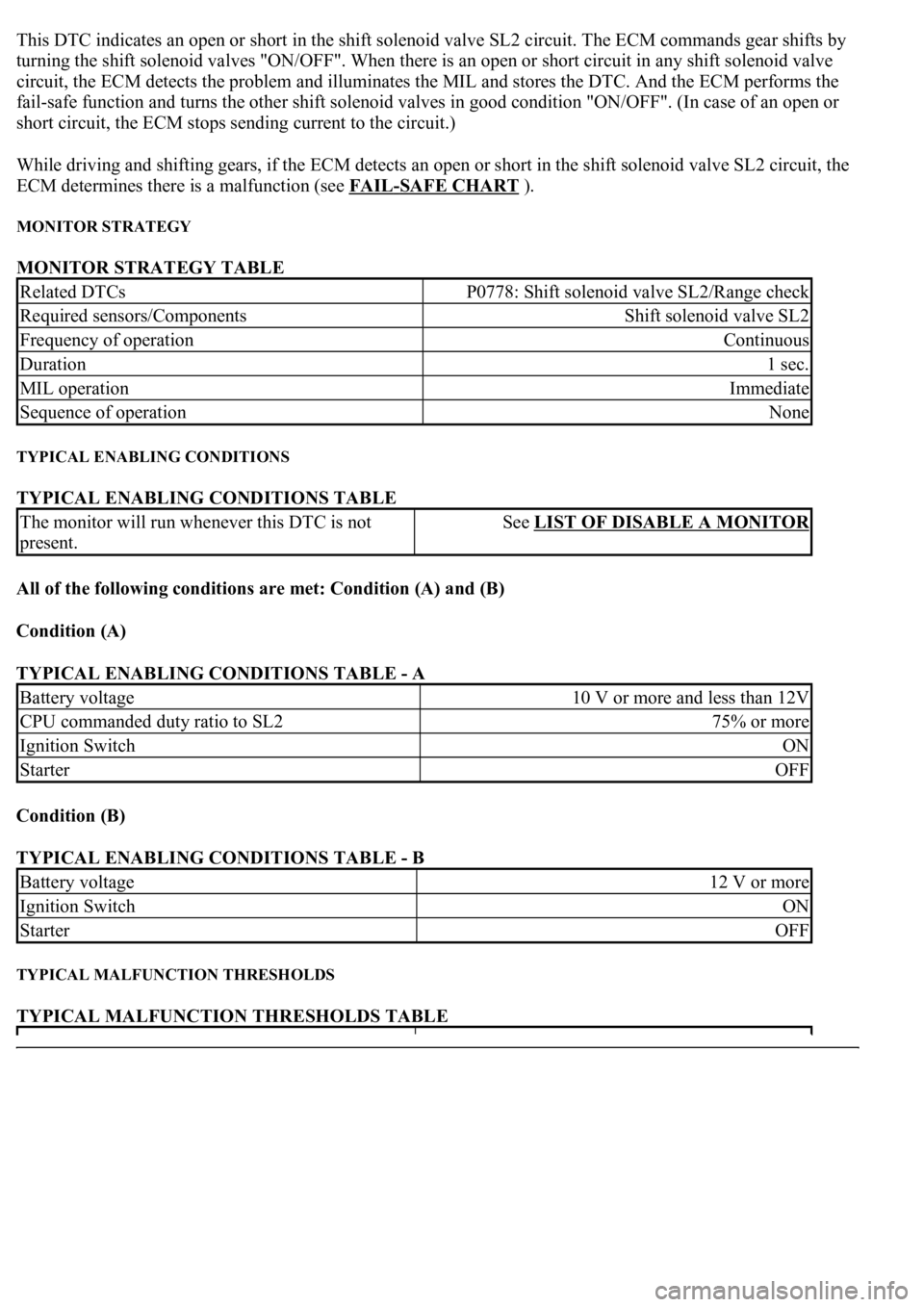
This DTC indicates an open or short in the shift solenoid valve SL2 circuit. The ECM commands gear shifts by
turning the shift solenoid valves "ON/OFF". When there is an open or short circuit in any shift solenoid valve
circuit, the ECM detects the problem and illuminates the MIL and stores the DTC. And the ECM performs the
fail-safe function and turns the other shift solenoid valves in good condition "ON/OFF". (In case of an open or
short circuit, the ECM stops sending current to the circuit.)
While driving and shifting gears, if the ECM detects an open or short in the shift solenoid valve SL2 circuit, the
ECM determines there is a malfunction (see FAIL
-SAFE CHART ).
MONITOR STRATEGY
MONITOR STRATEGY TABLE
TYPICAL ENABLING CONDITIONS
TYPICAL ENABLING CONDITIONS TABLE
All of the following conditions are met: Condition (A) and (B)
Condition (A)
TYPICAL ENABLING CONDITIONS TABLE - A
Condition (B)
TYPICAL ENABLING CONDITIONS TABLE - B
TYPICAL MALFUNCTION THRESHOLDS
TYPICAL MALFUNCTION THRESHOLDS TABLE
Related DTCsP0778: Shift solenoid valve SL2/Range check
Required sensors/ComponentsShift solenoid valve SL2
Frequency of operationContinuous
Duration1 sec.
MIL operationImmediate
Sequence of operationNone
The monitor will run whenever this DTC is not
present.See LIST OF DISABLE A MONITOR
Battery voltage10 V or more and less than 12V
CPU commanded duty ratio to SL275% or more
Ignition SwitchON
StarterOFF
Battery voltage12 V or more
Ignition SwitchON
StarterOFF
Page 2822 of 4500
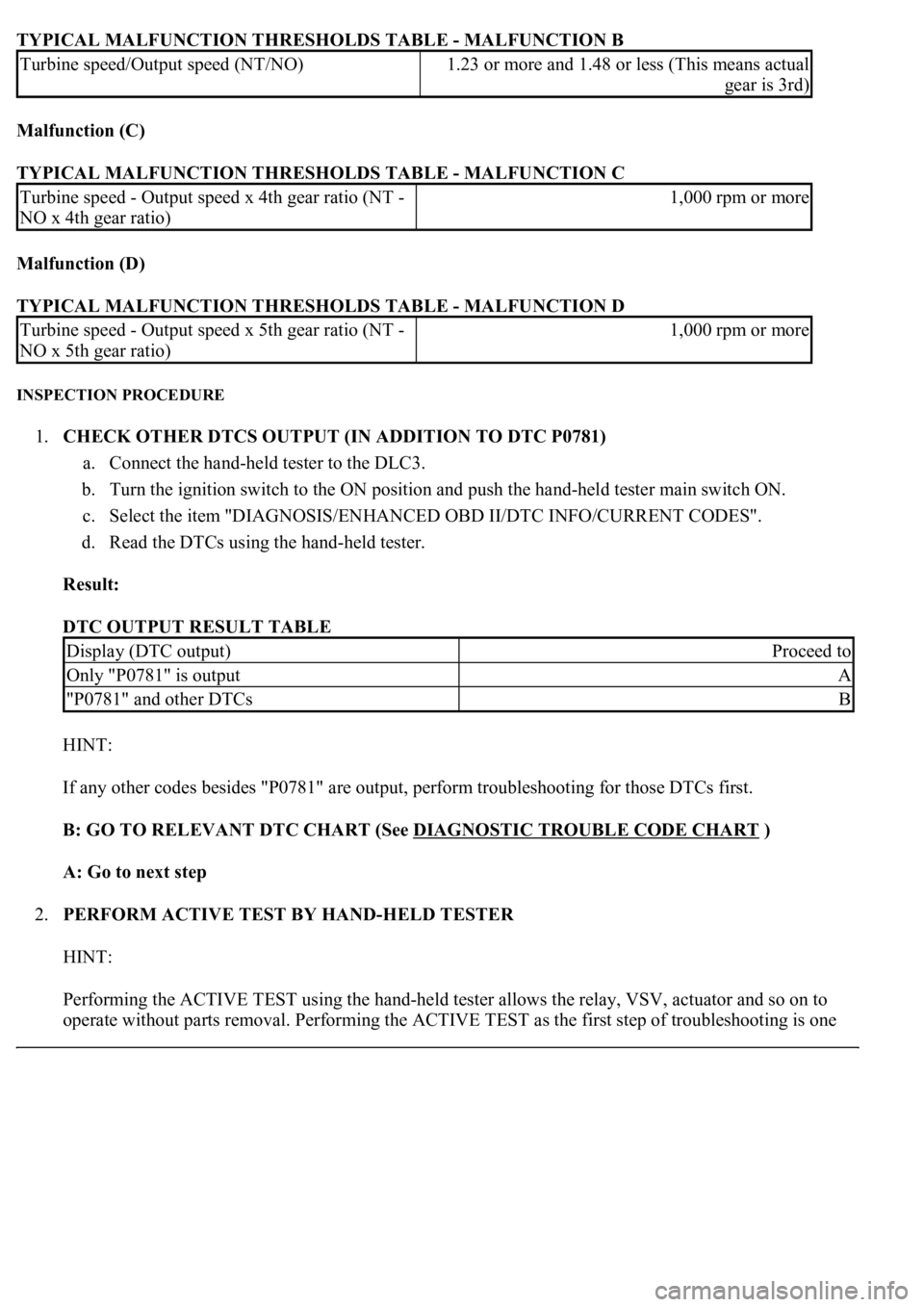
TYPICAL MALFUNCTION THRESHOLDS TABLE - MALFUNCTION B
Malfunction (C)
TYPICAL MALFUNCTION THRESHOLDS TABLE - MALFUNCTION C
Malfunction (D)
TYPICAL MALFUNCTION THRESHOLDS TABLE - MALFUNCTION D
INSPECTION PROCEDURE
1.CHECK OTHER DTCS OUTPUT (IN ADDITION TO DTC P0781)
a. Connect the hand-held tester to the DLC3.
b. Turn the ignition switch to the ON position and push the hand-held tester main switch ON.
c. Select the item "DIAGNOSIS/ENHANCED OBD II/DTC INFO/CURRENT CODES".
d. Read the DTCs using the hand-held tester.
Result:
DTC OUTPUT RESULT TABLE
HINT:
If any other codes besides "P0781" are output, perform troubleshooting for those DTCs first.
B: GO TO RELEVANT DTC CHART (See DIAGNOSTIC TROUBLE CODE CHART
)
A: Go to next step
2.PERFORM ACTIVE TEST BY HAND-HELD TESTER
HINT:
Performing the ACTIVE TEST using the hand-held tester allows the relay, VSV, actuator and so on to
operate without parts removal. Performin
g the ACTIVE TEST as the first step of troubleshooting is one
Turbine speed/Output speed (NT/NO)1.23 or more and 1.48 or less (This means actual
gear is 3rd)
Turbine speed - Output speed x 4th gear ratio (NT -
NO x 4th gear ratio)1,000 rpm or more
Turbine speed - Output speed x 5th gear ratio (NT -
NO x 5th gear ratio)1,000 rpm or more
Display (DTC output)Proceed to
Only "P0781" is outputA
"P0781" and other DTCsB
Page 2823 of 4500
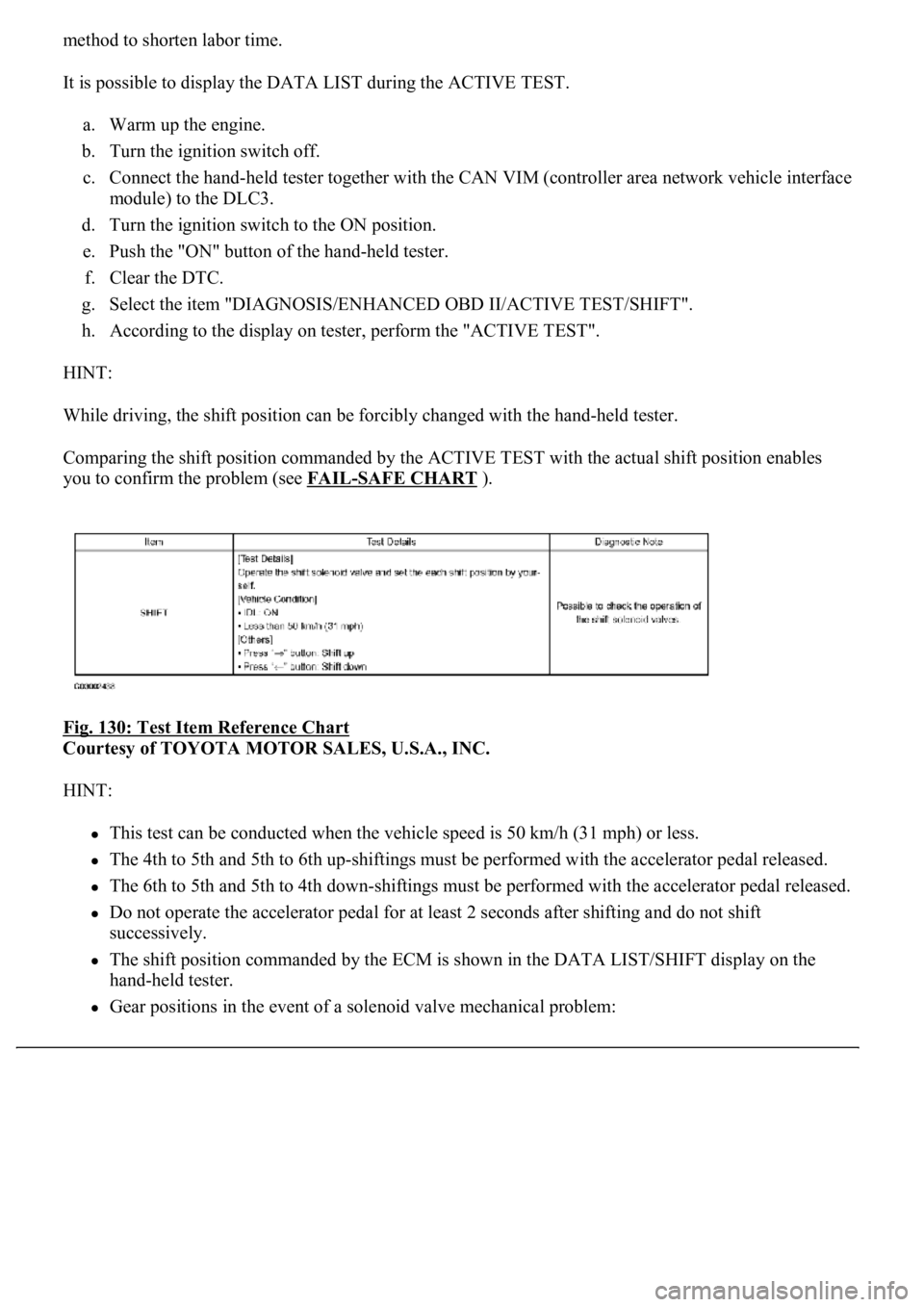
method to shorten labor time.
It is possible to display the DATA LIST during the ACTIVE TEST.
a. Warm up the engine.
b. Turn the ignition switch off.
c. Connect the hand-held tester together with the CAN VIM (controller area network vehicle interface
module) to the DLC3.
d. Turn the ignition switch to the ON position.
e. Push the "ON" button of the hand-held tester.
f. Clear the DTC.
g. Select the item "DIAGNOSIS/ENHANCED OBD II/ACTIVE TEST/SHIFT".
h. According to the display on tester, perform the "ACTIVE TEST".
HINT:
While driving, the shift position can be forcibly changed with the hand-held tester.
Comparing the shift position commanded by the ACTIVE TEST with the actual shift position enables
you to confirm the problem (see FAIL
-SAFE CHART ).
Fig. 130: Test Item Reference Chart
Courtesy of TOYOTA MOTOR SALES, U.S.A., INC.
HINT:
This test can be conducted when the vehicle speed is 50 km/h (31 mph) or less.
The 4th to 5th and 5th to 6th up-shiftings must be performed with the accelerator pedal released.
The 6th to 5th and 5th to 4th down-shiftings must be performed with the accelerator pedal released.
Do not operate the accelerator pedal for at least 2 seconds after shifting and do not shift
successively.
The shift position commanded by the ECM is shown in the DATA LIST/SHIFT display on the
hand-held tester.
Gear positions in the event of a solenoid valve mechanical problem:
Page 2838 of 4500
P0979: Range check (Low resistance)
TYPICAL ENABLING CONDITIONS TABLE - P0979
P0980: Range check (High resistance)
TYPICAL ENABLING CONDITIONS TABLE - P0980
TYPICAL MALFUNCTION THRESHOLDS
P0979: Range check (Low resistance)
TYPICAL MALFUNCTION THRESHOLDS TABLE - P0979
P0980: Range check (High resistance)
TYPICAL MALFUNCTION THRESHOLDS TABLE - P0980
COMPONENT OPERATING RANGE
COMPONENT OPERATING RANGE TABLE
WIRING DIAGRAM
The monitor will run whenever this DTC is not
present.See LIST OF DISABLE A MONITOR
Shift solenoid valve S3ON
Battery voltage8 V or more
Ignition switchON
StarterOFF
The monitor will run whenever this DTC is not
present.See LIST OF DISABLE A MONITOR
Shift solenoid valve S3OFF
Battery voltage8 V or more
Ignition switchON
StarterOFF
Shift solenoid valve S3 resistance8 ohms or less
Shift solenoid valve S3 resistance100 kohms or more
Shift solenoid valve S3Resistance 11 to 15ohms at 20° C (68° F)
Page 2844 of 4500
P0983: Range check (High resistance)
TYPICAL ENABLING CONDITIONS TABLE - P0983
TYPICAL MALFUNCTION THRESHOLDS
P0982: Range check (Low resistance)
TYPICAL MALFUNCTION THRESHOLDS TABLE - P0982
P0983: Range check (High resistance)
TYPICAL MALFUNCTION THRESHOLDS TABLE - P0983
COMPONENT OPERATING RANGE
COMPONENT OPERATING RANGE TABLE
WIRING DIAGRAM
Shift solenoid valve S4ON
Battery voltage8 V or more
Ignition switchON
StarterOFF
The monitor will run whenever this DTC is not
present.See LIST OF DISABLE A MONITOR
Shift solenoid valve S4OFF
Battery voltage8 V or more
Ignition switchON
StarterOFF
Shift solenoid valve S4 resistance8 ohms or less
Shift solenoid valve S4 resistance100 kohms or more
Shift solenoid valve S4Resistance: 11 to 15 ohms at 20°C (68°F)
Page 2850 of 4500
P0983: Range check (High resistance)
TYPICAL ENABLING CONDITIONS TABLE - P0983
TYPICAL MALFUNCTION THRESHOLDS
P0982: Range check (Low resistance)
TYPICAL MALFUNCTION THRESHOLDS TABLE - P0982
P0983: Range check (High resistance)
TYPICAL MALFUNCTION THRESHOLDS TABLE - P0983
COMPONENT OPERATING RANGE
COMPONENT OPERATING RANGE TABLE
WIRING DIAGRAM
Battery voltage8 V or more
Ignition switchON
StarterOFF
The monitor will run whenever this DTC is not
present.See LIST OF DISABLE A MONITOR
Shift solenoid valve SROFF
Battery voltage8 V or more
Ignition switchON
StarterOFF
Shift solenoid valve SR resistance8 ohms or less
Shift solenoid valve SR resistance100 kohms or more
Shift solenoid valve SRResistance: 11 to 15 ohms at 20°C (68°F)
Page 2859 of 4500
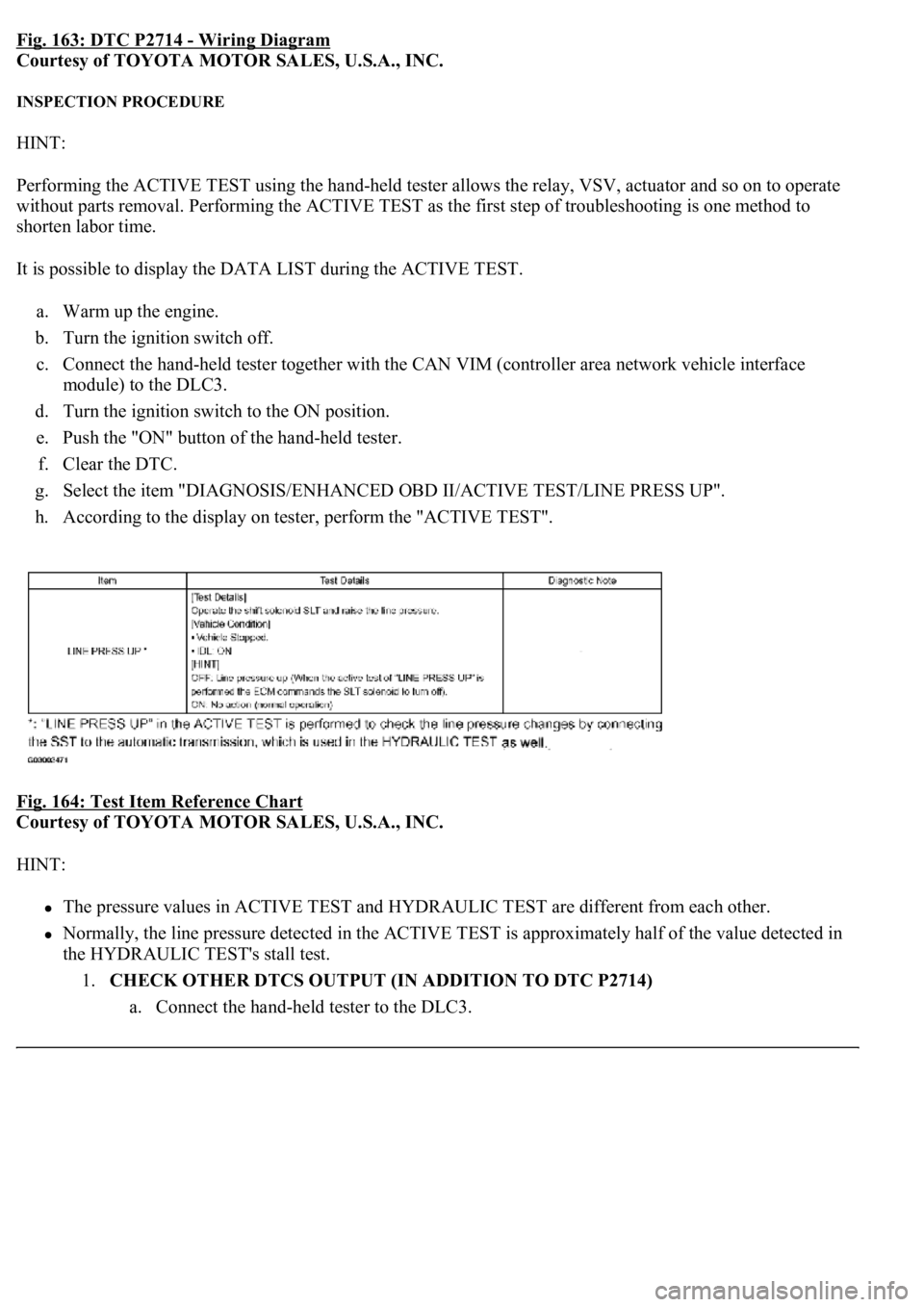
Fig. 163: DTC P2714 - Wiring Diagram
Courtesy of TOYOTA MOTOR SALES, U.S.A., INC.
INSPECTION PROCEDURE
HINT:
Performing the ACTIVE TEST using the hand-held tester allows the relay, VSV, actuator and so on to operate
without parts removal. Performing the ACTIVE TEST as the first step of troubleshooting is one method to
shorten labor time.
It is possible to display the DATA LIST during the ACTIVE TEST.
a. Warm up the engine.
b. Turn the ignition switch off.
c. Connect the hand-held tester together with the CAN VIM (controller area network vehicle interface
module) to the DLC3.
d. Turn the ignition switch to the ON position.
e. Push the "ON" button of the hand-held tester.
f. Clear the DTC.
g. Select the item "DIAGNOSIS/ENHANCED OBD II/ACTIVE TEST/LINE PRESS UP".
h. According to the display on tester, perform the "ACTIVE TEST".
Fig. 164: Test Item Reference Chart
Courtesy of TOYOTA MOTOR SALES, U.S.A., INC.
HINT:
The pressure values in ACTIVE TEST and HYDRAULIC TEST are different from each other.
Normally, the line pressure detected in the ACTIVE TEST is approximately half of the value detected in
the HYDRAULIC TEST's stall test.
1.CHECK OTHER DTCS OUTPUT (IN ADDITION TO DTC P2714)
a. Connect the han
d-held tester to the DLC3.